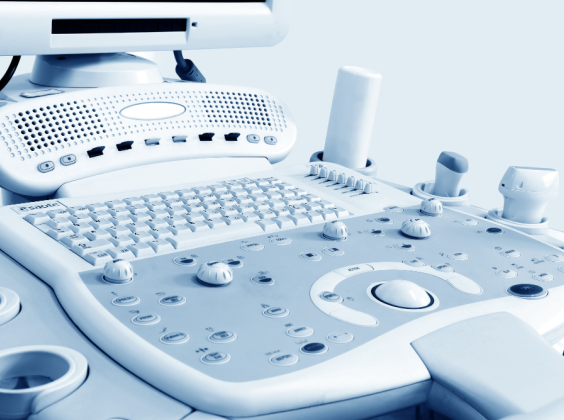
Written by

Cranfield, UK, 30th April 2024, Written by Mustafa Hassan –
As we slowly head towards the summer, April was another zooming month in the ultrasound market. More product launches, more funding raised and more commercial approvals.
In this monthly news round-up, we offer some of the latest news and developments impacting the Ultrasound market that has caught our attention in the last month.
New Product Launches
1. GE HealthCare has launched the Voluson Signature 20 and 18 AI-enhanced ultrasound systems for women’s health. The systems address the ongoing healthcare worker shortages and increased demand on scanning services. The cart-based solutions both have in built AI solutions including voice commands, SonoLyst for auto fetal anatomy identification and analysis, SonoPelvicFloor for auto pelvic floor assessment, fibroid mapping and fetalHS for fetal heart assessment. The AI solutions aim to decrease exam time through a reduction of steps/keystrokes for the clinician. The SonoLyst AI software inclusion expands on GE HealthCare’s partnership with Intelligent Ultrasound incorporating their AI technology as standard on more of their systems. The systems also have the option to include the Vscan Air CL wireless dual probe, to allow for easier scanning and manoeuvring.
Whilst the availability of a wireless probe on a cart system is new, GE HealthCare follows Mindray’s progression with its TE Air handheld ultrasound device and TEX 20 system. Similarly, the voice assist feature, whilst new to cart systems, is already available on compact systems (SonoSite Voice Assist from Fujifilm SonoSite), and handheld devices (Voice Controls by Clarius). GE HealthCare will use the innovations to strengthen its mid-range and high-end offerings, catering to those with increasingly tighter budgets.
2. AmCAD BioMed has announced the launch of its updated thyroid ultrasound AI. The software is designed to help streamline scanning workflows and enhance diagnostic accuracy through real-time positional guidance. Given the time required for unassisted thyroid scanning and the complexity of nodule identification, the software will cut this time down substantially, enabling less experienced clinicians to conduct the exams to the same standard as other clinicians.
3. The Bill and Melinda Gates Foundation announced new portable ultrasound technology at the WomenLift Health Global Conference 2024. The announcement outlined a portable ultrasound device with AI functionality aimed at tackling the disparities in maternal care in the remote regions of Africa. This is in an effort to decrease maternal and fetal related mortality rates. The device is part of a wider effort by the foundation to develop low-cost equipment to aid in identifying life threatening diseases sooner. The Bill and Melinda Gates Foundation has committed $370M annually from 2023-2027 to support developments in women’s health. It notably donated $5M to Butterfly who just this month announced the second phase of its efforts to bring portable ultrasound into Sub-Saharan Africa. However, little is currently known about the new devices, or the partners involved with the development of the technology. It will be interesting to see how this new ultrasound device fits into their efforts and what it means for current partnerships.
4. EXO has announced the availability of its newly FDA cleared Cardiac and Lung AI on its EXO Iris handheld ultrasound device. These new additions add to the growing diagnostic AI portfolio of the company totalling 5 natively developed models. EXO has a large focus on AI development with the target to double its approved solutions by 2025. The solutions look to enable care providers to monitor patients and distinguish symptoms outside of the care setting more readily. This will work to reduce patient visits to the hospital and free up imaging clinician time.
The added solutions increase the use cases for the device, making it applicable to several clinical settings. As such it will be more valuable to intermediate and novice users who need to scan multiple body areas at the point of care (POC). With its handheld ultrasound device, AI solutions and Works workflow solution, Exo is one of the few vendors offering a complete ecosystem to enable increased ultrasound imaging in point of care departments.
5. Fujifilm has introduced a transducer for On-Pump Intracardiac Echocardiography (OPIE) for septal myectomy. The transducer is the first of its kind for the evaluation of ventricular thickness during septal myectomy surgery. Currently surgeons perform the procedure based on pre-surgical transoesophageal echocardiography. However this new transducer allows for real-time measurements during the surgery to ensure precision and optimum resection. The transducer is compatible with Fujifilm’s ARIETTA Precision surgical ultrasound cart. The development of this technology will help to ensure better outcomes for patients who have undergone high risk treatments, by providing surgeons with precise data and visualisation at the point of surgery.
Regulatory Approvals
6. Us2.ai received FDA clearance for their Us2.v2 echocardiogram solution. The v2 model includes 45 automated echo parameters, expanding its previous offering of around 10. V2 includes strain imaging, auto GLS quantification, regional strain to aid in the detection of coronary artery disease, aortic stenosis measurements and comprehensive qualitative analysis of cardiac structure and function. Us2.v2 has real time auto image processing including explained AI output, so clinicians can evaluate all automated outputs. The software can streamline the diagnostic process for cardiac complications, such as aortic stenosis, Heart failure with preserved ejection fraction (HFpEF) and amyloidosis.
With Us2.v2, the company looks to be moving towards cardiac disease detection and providing a more comprehensive option for clinicians. By providing explained reasoning behind the AI analysis, it can help clinicians to have a greater level of trust in the algorithms.
7. Clarius PAL HD3 wireless dual-array handheld ultrasound has received CE Mark certification. It is now available in Canada, Europe, the UK, Australia and the United States.
8. Provisio Medical has received FDA approval for its SLT IVUS system. The system includes a catheter with integrated intravascular ultrasound to simultaneously assess blood vessel lumen and obtain vessel measurements. Provisio’s system uses Sonic Lumen Tomography (SLT). The incorporation of this ultrasound technology into the catheter can be used in the treatment of patients with peripheral vascular disease reducing their radiation exposure.
9. Telemed receives Korean FDA approval for its MicrUS Pro Ultrasound system. The MicrUs Pro is a handheld system that plugs directly into a smartphone, tablet, or PC to provide easy imaging outside of the traditional clinical setting. This approval aligns with the growth of the handheld market within the APAC region, as users begin to see its value, especially in the plastic surgery and anaesthesia markets.
New Partnerships
10. Fujifilm has partnered with Brainlab as the exclusive distributor of its Arietta precision ultrasound. The distribution deal is the first part of the companies’ long term partnership plans to combine Arietta with Brainlab’s surgical navigation systems to create an end-to-end intraoperative technology for neurosurgery. Brainlab’ software shows misalignments between intraoperatively acquired 3D ultrasound and preoperative scans, allowing clinicians to adapt to patient anatomies in real time. The surgical market is consolidated between GE HealthCare and Fujifilm. However, GE HealthCare has increasingly gained market share since its acquisition of BK Medical. This partnership will allow Fujifilm to keep pace with GE HealthCare in the more niche surgical markets, such as neurosurgery.
11. Viz.ai and iCardio.ai have partnered to develop an aortic stenosis detection AI to aid in the rapid screening of patients at the point of care. The companies look to combine iCardio.ai’s aortic stenosis detection algorithm that recently received FDA break through device designation, with Viz.ai’s Cardio Suite. The Cardio Suite offers AI algorithms for the detection of Pulmonary embolism, Aortic dissection and abdominal aortic aneurysm, hypertrophic cardiomyopathy, STEMI and Heart failure, along with automated patient reporting and a neuro to cardio referral system. The incorporation of iCardio.ai’s solution into the suite will expand Viz.ai’s multi-modality cardiology screening tool to provide a more comprehensive tool for the POC. This more comprehensive offering will naturally benefit Viz.ai, and also iCardio.ai and the other partners by association.
12. Butterfly Network and ThinkSono have partnered to release ThinkSono’s DVT guidance solution on the Butterfly Garden. DVT guidance solution enables novice clinicians to learn how to perform a DVT ultrasound scan. It is an iOS app available on both the garden and the app store, meaning clinicians can use their phones or an iPad to receive real-time guidance easily. Read our coverage of the CE approval in last month’s round up to learn more about the product and its market impact.
Funding
13. This month, Koios Medical opened up a $9m funding round to the public; primarily radiologists and Industry Partners. To date, the company has raised $8.3m of the $9m target. Similar public funding rounds have been released in the past (e.g., ThinkSono in 2023). However, Signify Research believes this is the first to be done by a company with a portfolio as advanced as Koios Medical in terms of regulatory cleared solutions and vendor partnerships.
By offering a public funding round, Koios Medical will help raise the company profile among radiologists – its target market. Having raised funding in the past, a public funding round will also ensure that no single investor owns a significant portion of the company.
Other
14. GE HealthCare added Caption AI’s point-of-care (Caption Guidance) solution to its Vscan Air SL handheld device. The AI software provides automated ejection fraction information to aid clinicians in cardiac assessments, allowing inexperienced technicians to capture diagnostic images in the POC setting. Many of GE HealthCare’s closest handheld ultrasound competitors still lack ultrasound guidance AI tools. The addition of the Caption Guidance lowers the learning curve for performing ultrasound imaging and opens up the opportunity for ultrasound to be used in emergency settings by novice clinicians. It can also be used by more experienced ultrasound users to reduce intra-operator variability and standardise imaging.
15. EchoNous announced the forthcoming release of Kosmos 2.2 on Apple iOS. The update will bring workflow improvements to POCUS imaging. The update includes the new auto doppler for PW and TDI software which auto positions the doppler sample gate. The update also includes an auto preset for the Torse One probe. The update will help reduce variance in clinician images and decrease time spent on positioning, especially for novice users. This will help less experienced clinicians to obtain the highest level of clarity in their imaging and save time when moving from one exam to another.
Until next time, stay connected.
Are there any stories you believe we have missed? If so, please let us know. We welcome further conversations on the trends specifically impacting the markets highlighted.
Signify Research covers the market dynamics impacting the ultrasound market in its annual Ultrasound Service. The 2024 service will include:
· Ultrasound Equipment 2024 Report
· Ultrasound Transducers and Catheters Report
· Ultrasound AI Report
· Ultrasound Equipment 6 – month update Report
If you are interested in learning more about our Ultrasound service, please reach out.
